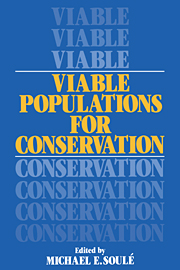Book contents
- Frontmatter
- Contents
- List of contributors
- Preface
- 1 Introduction
- 2 The demography of chance extinction
- 3 Extinction models and mammalian persistence
- 4 Minimum viable population size in the presence of catastrophes
- 5 Minimum viable populations: coping with uncertainty
- 6 Effective population size, genetic variation, and their use in population management
- 7 Spatial structure and population vulnerability
- 8 Managing critically endangered species: the Sumatran rhino as a case study
- 9 The role of interagency cooperation in managing for viable populations
- 10 Where do we go from here?
- Index
1 - Introduction
Published online by Cambridge University Press: 21 January 2010
- Frontmatter
- Contents
- List of contributors
- Preface
- 1 Introduction
- 2 The demography of chance extinction
- 3 Extinction models and mammalian persistence
- 4 Minimum viable population size in the presence of catastrophes
- 5 Minimum viable populations: coping with uncertainty
- 6 Effective population size, genetic variation, and their use in population management
- 7 Spatial structure and population vulnerability
- 8 Managing critically endangered species: the Sumatran rhino as a case study
- 9 The role of interagency cooperation in managing for viable populations
- 10 Where do we go from here?
- Index
Summary
And of every living thing of all flesh, two of every sort shalt thou bring into the ark.
GenesisDefinition: How much is enough?
Given biblical precedence, it is not surprising that for millennia, a pair (male and female) has been deemed sufficient to initiate, if not perpetuate, a population. In fact, there is more than scriptural authority behind this myth. With luck, two can indeed be a sufficient number of founders.
What is luck? Without going into theories of randomness and probability, luck implies a fortunate or unusual circumstance leading to a good result. The result of interest in this book is the survival of a population in a state that maintains its vigor and its potential for evolutionary adaptation. Such a population is a viable population. Legend does not question Noah's success with each of his multitudinous experiments. He must have been very lucky indeed. He also had some advantages over us, not the least of which was a fresh, well-watered planet.
The problem that we address in this book is ‘How much is enough?’. Put more concretely, it is: What are the minimum conditions for the long-term persistence and adaptation of a species or population in a given place? This is one of the most difficult and challenging intellectual problems in conservation biology.
- Type
- Chapter
- Information
- Viable Populations for Conservation , pp. 1 - 10Publisher: Cambridge University PressPrint publication year: 1987
- 26
- Cited by



